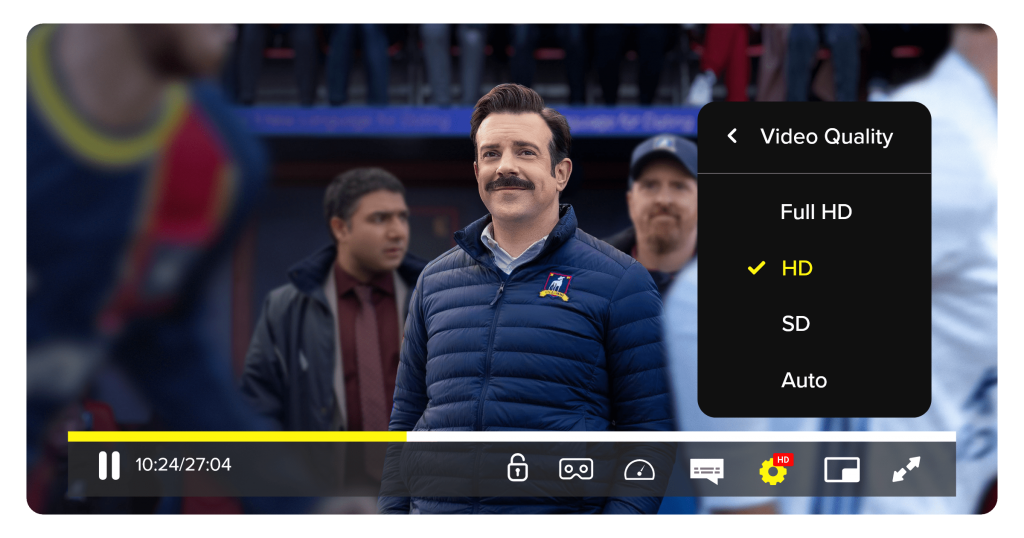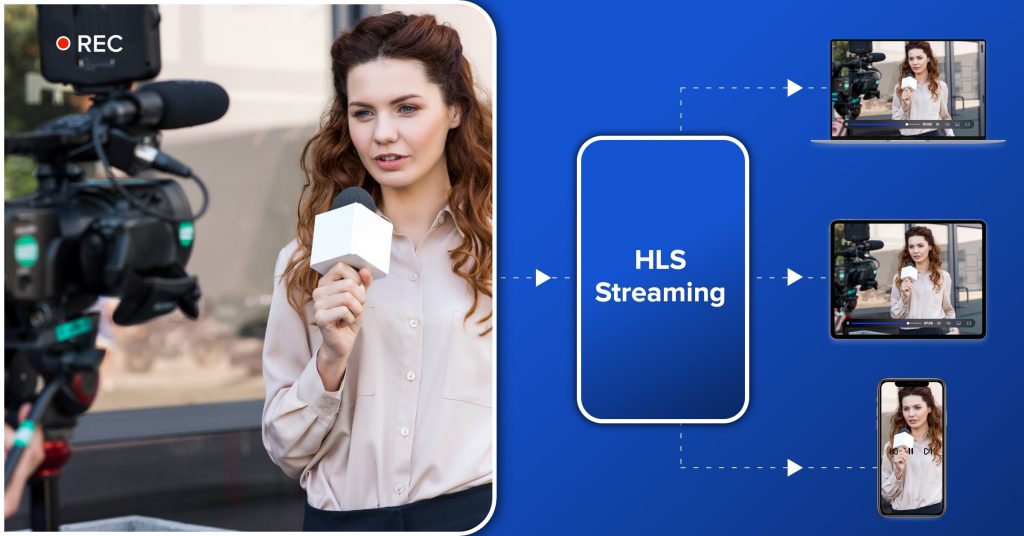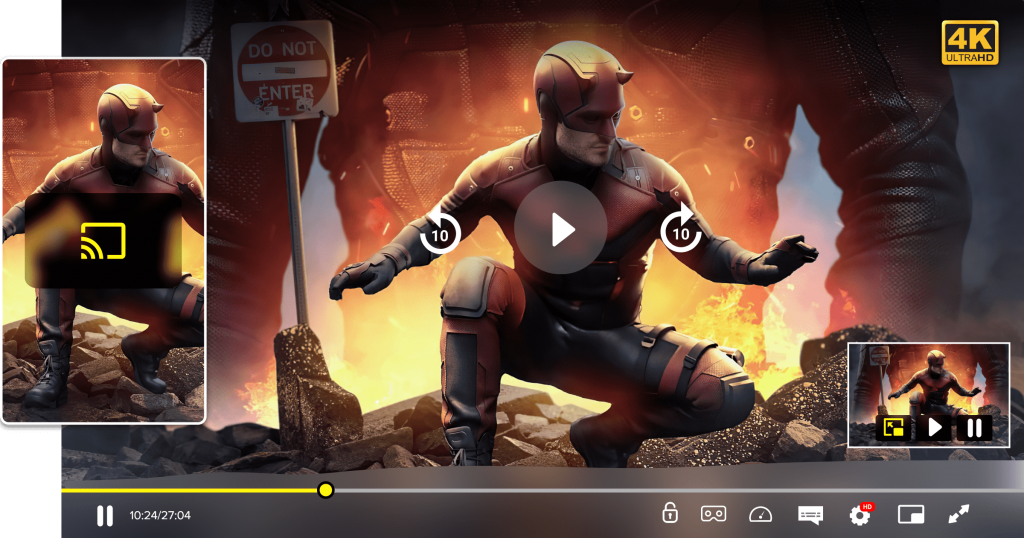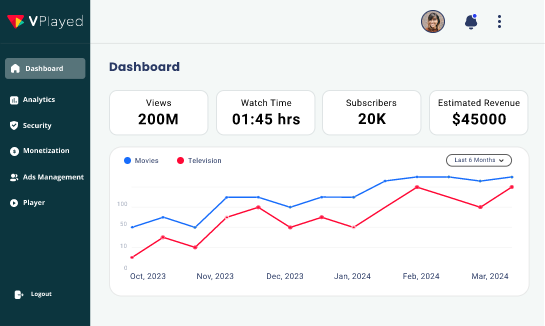HLS Streaming What Is it & How Does HLS Video Streaming Work?

Let’s begin this blog by exploring HLS streaming—a groundbreaking HTTP-based protocol transforming video and also audio streaming on the Internet.
HLS caters to diverse devices, ensuring smooth playback regardless of network conditions.
So, what exactly is HLS streaming? It breaks video into smaller segments sent via HTTP to viewers.
“In 2020, live streamers constituted over a third of Internet users, with one in ten in the US/UK engaging in live content broadcasting. By 2024, an astounding 82% of Internet usage will be dedicated to streaming video.”
HLS adapts dynamically to changing network conditions, ensuring a consistent viewing experience.
In this blog, we will introduce you to HLS video streaming, explaining how it works to deliver online content.
Whether you are a content creator, broadcaster, or interested in video platforms for your business, understanding HLS is invaluable. Let’s get going.
Table of Contents
What is HLS Streaming?
Basically, HTTP Live Streaming (HLS) is a streaming protocol that facilitates the delivery of video and also audio content over the Internet.

Built on the HTTP protocol, which forms the foundation of the World Wide Web, HLS is designed to work seamlessly with a wide array of devices, including computers, mobile devices, tablets, and also smart TVs.
Its broad compatibility with modern media players and also devices makes it an accessible solution for video creators and end users alike.
Nevertheless, HLS streaming boasts several prominent features, such as closed captions, audio and video alternates, metadata with timestamps, advertisement insertion, content protection, and also fast forward.
As a result, most streaming and distribution services widely support HLS, contributing to its widespread adoption.
In the year 2017, Adobe announced the discontinuation of support for RTMP beyond the end of 2020, prompting a greater focus on HLS streaming solutions. HLS quickly emerged as a leading candidate to replace RTMP due to its capabilities and compatibility.
One of the key strengths of HLS lies in its ability to deliver high quality content across various network devices, playback platforms, and also network conditions, making it an ideal choice for broadcasting media to large and dispersed audiences.
Although HLS was originally developed by Apple, it has now become the industry standard for delivering online video content across multiple platforms, devices, and also browsers.
Its versatility and also widespread support have solidified HLS’s position as a go-to protocol for video streaming.
How does HLS streaming work?
HLS employs a unique methodology to ensure seamless video delivery. It takes a large video file and meticulously divides it into smaller, variable-length segments.
As users stream the video, the video player downloads and plays these segments, all while maintaining a cache of these segments in case of network disruptions.
Furthermore, HLS offers the flexibility to create segments at different resolutions and bitrates, catering to a spectrum of device capabilities.
On the server side, HLS undergoes two key processes: encoding, which reformats the video data for universal compatibility, and segmenting, which breaks the video into several short segments.

Having grasped the essence of “What is HLS streaming,” it’s time to know a bit about how HLS streaming works in real time.
To commence, the HLS protocol breaks video data into 10-second segments, each utilizing the file extension.
These segments are stored on an HTTP server and also distributed to viewers’ network devices via HTTP. HLS leverages manifest files and media segments for this purpose.
The manifest, also called the playlist, comprises a list of media segments that constitute the video content.
Apart from this, HLS streaming works in a way that it houses crucial metadata like segment length and also encryption keys for decryption.
The media segments themselves hold the actual video and also audio data, transmitted to viewers through the HTTP protocol.
As viewers watch the video, their devices continuously download new media segments and also update the playlist to reflect the current state of the stream.
This dynamic adaptation allows HLS to ensure a seamless viewing experience, effectively adjusting to changing network conditions.
Advantages of HLS Video Streaming:
HLS boasts a range of advantages. Notably, it excels in adaptive bitrate streaming, encryption, and DRM, ensuring a secure and versatile streaming experience.
Its compatibility across various browsers, devices, and platforms makes it a preferred choice for both on-demand and live streaming scenarios.
One notable advantage of HLS is its viewer-friendly feature that allows seamless bitrate switching at any point in time.
Unlike MPEG-DASH, which some clients support but not universally, HLS finds consistent support.

1. Highly Compatible With Multiple Devices:
HLS streaming boasts exceptional device compatibility, supporting a wide range of network devices.
Including desktop and mobile web browsers, as well as native apps on iOS, Android, and other platforms. Isn’t that great?
This extensive support ensures that a large audience can access video content effortlessly, without encountering compatibility challenges.
Whether viewers are on desktops, smartphones, or smart TVs, HLS streaming offers a seamless and also enjoyable experience for all.
2. Good User Experience:
HLS video streaming provides a superior user experience through adaptive bitrate.
This ingenious technology automatically adjusts the video quality based on the viewer’s network connection. Ensuring an uninterrupted viewing experience even in varying network conditions.
Furthermore, HLS works in a way that it exhibits relatively low latency, thereby minimizing the overall delay between the source video and also its reception.
By the end user, making it ideal for real time interactions (live events).
3. Effective Bandwidth Utilization:
One of the standout benefits of utilizing streaming online is its highly efficient bandwidth management.
Making it an ideal choice for content creators seeking to deliver video content without incurring exorbitant data costs.
Through its adaptive bitrate streaming mechanism, HLS intelligently adjusts the video quality according to the network state.
This adaptability further enhances the overall user experience and also contributes to HLS’s reputation as a versatile and reliable video streaming solution.
4. Delivery and Scaling:
HLS video streaming simplifies the distribution of live video to a vast audience.
Supported by most web browsers and also operating systems, HLS can efficiently push content through web servers in content delivery networks (CDNs).
As a result, the digital load is distributed across HTTP server networks, enabling efficient caching of audio-video chunks for delivery to viewers in various locations.
This ensures that viewers can access video content with minimal delays, no matter their geographical location.
5. Easy To Implement:
HLS’s ease of implementation makes it a popular choice for content creators seeking to establish an online video streaming solution.
Compatible with ordinary web servers and easily integrated with other video infrastructures like CDNs, HLS offers a straightforward setup process.
Moreover, its interoperability with a wide range of software and also hardware platforms simplifies the overall content distribution.
To a diverse audience who keeps an interest in watching online video streaming content.
6. High Quality Video:
HLS is renowned for its ability to deliver high-quality video, and interestingly, it can handle resolutions of up to 4K. Yes! You read right.
This capability has earned HLS the reputation of being the go-to solution for delivering high-definition video content to end viewers.
Furthermore, HLS offers support for a diverse range of video codecs, empowering content creators to deliver videos in multiple formats.
This flexibility is essential for reaching and also engaging a wide audience. Whether it’s SD, HD, or UHD content,
HLS streaming caters to the specific needs and preferences of both content providers and their audiences.
Recommended Reading
7. Good Error Resilience:
HLS is meticulously engineered to maintain a seamless viewing experience by being highly resilient to errors and interruptions.
Wondering how it achieves this remarkable resilience?. The answer lies in its ingenious use of HTTP for data transmission, enabling HLS to recover from errors and interruptions.
Moreover, HLS adopts a segmented approach to streaming, further enhancing its robustness.
In the event of minor faults or interruptions in some segments, HLS continues to deliver the video smoothly.
This fault-tolerant design contributes to the reliability and also stability of HLS video streaming.
Looking To Build Your Own VOD Platform
Start and Grow Your Video Streaming Service With 1000+ Features & 9+ Revenue Models.
 Highly Customizable
Highly Customizable Life Time Ownership
Life Time Ownership Own 100% of Your Revenue
Own 100% of Your Revenue
 Full-Branding Freedom
Full-Branding Freedom

8. DRM support:
HLS takes security seriously and enables secure streaming through encryption, ensuring video remains protected from unauthorized access.
This becomes particularly valuable for premium content restricted to paying subscribers, i.e. only authorized users can access the content.
Moreover, HLS goes the extra mile in safeguarding content by supporting Digital Rights Management (DRM) systems.
This security aspect contributes to the widespread adoption of HLS as a trusted and reliable video streaming solution in the industry.
HLS Video Streaming Benefits:
All in all, after seeing the benefits, we can say that HLS html5 streaming emerges as a powerful and versatile protocol, well-suited for diverse video streaming needs.
Its compatibility across a wide range of devices, adaptive bitrate streaming for an enriched user experience.
And support for high-quality video content make it a compelling choice for content creators and publishers.
Furthermore, HLS’s scalability and utilization of HTTP for data transmission simplify video delivery to a vast and geographically dispersed audience.
Whether for live broadcasts, video-on-demand services, or widespread distribution.
HLS video streaming provides a reliable and also efficient solution for delivering engaging video experiences to viewers all across the globe.
With its comprehensive device support, efficient bandwidth management, and also robust DRM capabilities, HLS ensures seamless and enjoyable video streaming across various devices.
Making the most out of the HLS, content creators can engage audiences worldwide and navigate the ever-evolving landscape of online video streaming with confidence.
When to Use HLS For Video Streaming:

When considering video streaming options, HLS streaming emerges as an excellent choice for various scenarios.
One common application of HLS streaming is in broadcasting live events, such as sporting events.
HLS proves its worth in such events with its minimal latency and ability to scale efficiently to accommodate a large number of viewers.
While there may be slight delays during live streams, HLS stands out as a reliable HTML5 video player, ensuring a seamless viewing experience.
Apart from this, HLS finds frequent use in on-demand video services, delivering high-quality content, including resolutions up to 4K.
And integrating smoothly with other video infrastructures like content delivery networks (CDNs).
HLS Streaming – A Versatile Solution For Superior Video Experiences
Another scenario where HLS shines is when compatibility with a wide range of network devices is essential. Hls streaming enjoys widespread support across diverse devices.
This broad compatibility makes it effortless to reach a vast audience without worrying about compatibility challenges.
Moreover, HLS’s adaptive bitrate streaming capabilities guarantee a smooth watching experience, even amidst fluctuating network connectivity.
Overall HLS video streaming stands as a versatile and also widely adopted protocol, perfectly suited for various online video streaming.
Whether for live Streaming or Video on-demand Platform , HLS proves its mettle, offering reliability, high-quality streaming with a diverse array of devices.
Note: When seeking a video streaming solution that ticks all the right boxes,
HLS streaming emerges as a top contender for content creators and also publishers seeking a superior viewing experience for their audiences.
Conclusion:
No doubt, HLS remains a prominent and widely-recognized video streaming protocol, catering to diverse applications.
Its impressive characteristics make it a compelling choice for a broad spectrum of scenarios.
HLS exhibits scalability, efficiency in bandwidth usage, and seamless integration with content delivery networks (CDNs).
Its support for encryption and also DRM systems further enhances its appeal, guaranteeing secure streaming of premium content.
Whether you are broadcasting live events, offering on-demand video, or exploring other possibilities.
HLS proves its worth by delivering high quality viewing experiences to your audience.
If you are convinced and keen to experience buffer-free streaming of HD quality videos, reach out to one of our product experts for a personalized one-on-one demo.
Frequently Asking Questions (FAQs)
HLS (HTTP Live Streaming) stands as a widely embraced video streaming protocol with remarkable versatility. Compatible with nearly any server and supported by a vast array of network devices, HLS takes the lead in delivering seamless streaming experiences.
What distinguishes HLS is its adaptive bitrate feature, enabling it to dynamically adapt the video and audio quality in accordance with varying network conditions. This versatility positions it as the preferred option for live content delivery across a wide spectrum of devices.
HLS operates by segmenting video content into small pieces and distributing them via HTTP. These segments are encoded at varying bitrates and stored on a server.
When a viewer initiates video playback, the player downloads and plays these segments based on the available network bandwidth. As a result, the player dynamically adjusts the video quality by switching between different bitrate segments, ensuring smooth playback, even in fluctuating network conditions.
HLS video streaming offers numerous benefits, starting with its extensive compatibility across diverse devices and platforms. The adaptive streaming feature ensures uninterrupted playback, adapting to changing network conditions seamlessly. On top of that, HLS supports on-demand and live streaming, thereby providing an enhanced user experience and allowing for easy integration with CDNs.
The top features of HLS video streaming encompass adaptive streaming, extensive device compatibility, resilient error handling for uninterrupted viewing, support for multiple audio and subtitle tracks, and efficient bandwidth management. Also, HLS ensures content protection through encryption and also seamless integration with DRM systems.
Numerous video platforms support HLS to facilitate smooth video delivery across devices. Prominent platforms like VPlayed, Vimeo, Brightcove, JW Player, and Kaltura offer robust HLS streaming capabilities. These platforms provide advanced tools and also infrastructure for HLS encoding, adaptive streaming, and seamless content delivery, ensuring exceptional viewing experiences for end-users.
HLS streaming is the ideal choice when you seek extensive device compatibility for your online video content. It proves highly advantageous in scenarios requiring adaptive streaming to seamlessly adjust video quality according to network conditions.
Apart from this, HLS comes highly recommended for live streaming events that demand real-time delivery of content.

